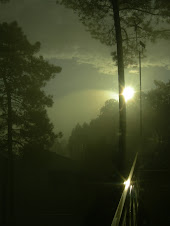When the pope says, "respect creation," people are going to listen. And over the past few years, religious figures representing all faiths have been increasingly spreading the same message to the 85 percent of the world's population that holds religious beliefs. From Ecumenical Patriarch Bartholomew, the leader of the Eastern Orthodox Church, to the Akal Takht, the highest temporal authority in Sikhism, spiritual leaders have been telling their followers that protecting the environment is their moral and religious duty. Here are eight ways members of religious groups are paying heed.
1. Campaigning for Climate Action
Though a faction of evangelical Christians has been notoriously cold to the climate change issue -- with some even calling it a "distraction" from "the great moral issues of our time," such as abortion, abstinence, and same-sex marriage -- other members of the same faith have been pressing the government to do more about global warming since at least 2006. "This is God's world, and any damage that we do to God's world is an offense against God himself," the Evangelical Climate Change Initiative, a group of more than 85 Christian leaders, wrote in its call to action. The U.K.-based development charity Christian Aid has been one of the loudest voices for change, with members marching on the London Stock Exchange, biking to Copenhagen, and beaming climate-justice slogans onto a power-station cooling tower to get that message across.
2. Building LEED-Certified Houses of Worship
With its reclaimed-wood exterior, recycled cinder blocks, and sunflower-husk cabinets, the synagogue of the Jewish Reconstructionist Congregation in Evanston, Illinois, is the country's first religious building to achieve the highest LEED rating from the U.S. Green Building Council. But it won't be the last. Ten U.S. congregations are already LEED-certified and more than 50 have applied for approval for their green churches, synagogues, chapels, seminaries, and other houses of worship. Eco-friendly changes at the the Prestonwood Baptist Church in Plano, Texas, to give just one example, have helped the congregation cut its yearly gas and water bill in half. "It was about making a sacred statement. If we were going to talk the talk, we needed to walk the walk," said Rabbi Brant Rosen of the Evanston synagogue. "The whole process forced us to look at our values in a deeper way."
3. Making Religious Rituals Lighter on the Earth
Like just about everything else we do, religious rituals can have a not-so-positive impact on the earth, one that members of various faiths are working to alleviate with clever updates on holiday traditions. Concerned that the palm leaves used on Palm Sunday are contributing to overexploitation of forests in Central America, more than 1,000 churches are now distributing sustainably harvested "eco-palms." Likewise, awareness about the water pollution caused by the dunking of plastic and plaster-of-paris idols into rivers as part of Hindu festivals celebrating Ganesha Chaturthi and the warrior goddess Durga has sparked a return to natural clay figurines colored with natural pigments that dissolve quickly and more harmlessly.
4. Greening Ramadan and the Hajj
Any event that brings 3 million people to one place offers plenty of opportunity for improved environmental practices, and the holy Muslim pilgrimage to Mecca, known as the hajj, is no exception. Our friends over at Green Prophet have reported that a variety of measures are being taken to green the hajj, including the creation of a fast train linking Saudi Arabia's holy cities, Mecca and Medina, with its largest port. Medina is additionally "reducing exhaust emissions for public transport, and reducing the number of plastic bottles used by pilgrims by improving the quality of tap drinking water."
Islam's holiest month of the year, Ramadan, is also getting a green makeover, with Chicago mosques using the holiday to educate Muslims about environmental issues, increased attention to the use of healthy and organic foods at fast-breaking meals in Jordan and Turkey, and a global online movement to use the holy month as an opportunity "to care about our environment, the earth, animals, and our health, practice positive and healthy habits, to make a positive impact, and make a difference."
5. Bringing Environmentalism to the Dinner Table
Going "eco-kosher" is a growing trend for American Jews, who are increasingly using organic and local foods at Sabbath dinners and other meals to "elevate their practice of Judaism" by making ethical eating choices. A controversy over a kosher slaughterhouse has also prompted the creation of a new kosher certification, Magen Tzedek, or shield of righteousness, that protects workers and the environment, and a boost in consumption of kosher grass-fed beef.
In related developments, a Jewish Farm School in Israel and the U.K.-based group Operation Noah are both promoting sustainable, self-sufficient agricultural practices, while Hindu temples are developing their own gardens and British Quakers are "implementing a strict food policy at the Quaker headquarters including total food recycling, a 35 percent increase in organic produce, and 40 percent of food sourced from greater London."
6. Saving Energy in Mosques
The Koran verse calling Allah "the light of the heavens and the earth" is reflected in the extensive use of lighting in mosques -- a beautiful architectural feature that's also a big energy drain. Mosques in Turkey, however, are reducing electricity costs by up to 65 percent by replacing conventional bulbs with energy-saving versions. The country's Religious Affairs Directorate is additionally establishing policies to save energy on heating and cooling, as well as ways to conserve water. Mosques in Manchester, the United Arab Emirates, Singapore, and Mumbai are also employing energy- and water-saving techniques including maximizing natural light, incorporating solar panels, installing low-flow taps, and harvesting rainwater.
7. Building Solar-Powered Temples
Hindus around the world are being urged to "openly bless environmental causes" and make their temples more environmentally friendly -- a call that some are already heeding. The BAPS Shri Swaminarayan Mandir temple and cultural center being developed in Chino Hills, California, will be entirely powered by a 60 kW solar system that returns electricity to the grid. The complex's design also incorporates solar tube lighting and extensive tree planting. Meanwhile, the Sri Venkateswara Temple in Tirupati, Andhra Pradesh, India -- perhaps the most-visited pilgrimage location in the world -- now uses solar-cooking technology instead of diesel generators to prepare some 30,000 meals per day.
8. Turning Vice into Virtue
In what's likely the most visually stunning example of religious groups going green, Buddhist monks from Thailand's Sisaket province collected a million beer bottles to build the beautiful Wat Pa Maha Chedi Kaew temple, an intricately patterned mix of green Heineken and brown local Chang beer containers. Even the washrooms and the crematorium are built of bottles. Buddhists from New York to Japan are also talking, in person and online, about how to use their practices to live lower-impact lives in harmony with nature.



.jpg)
.jpg)











Sem comentários:
Enviar um comentário